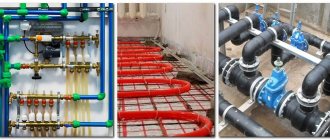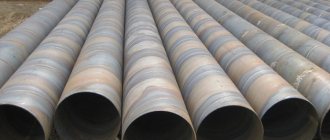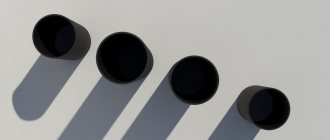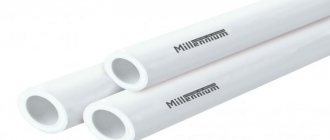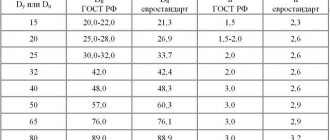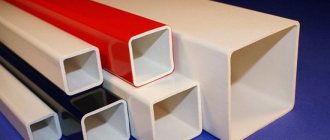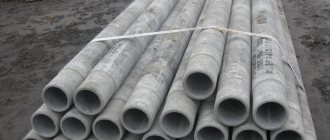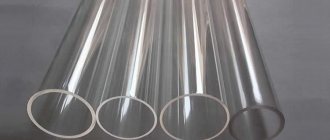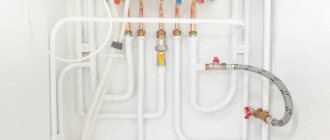What types of corrugated PVC pipes are there and what are they for? In what temperature range is corrugated PVC pipe and its GOST operating standards used? Why is it profitable to lay drainage from PVC pipes and what diameters of corrugated hose are in demand? Where is a steel broach hose used? How many years can a water supply system made from self-extinguishing PVC plastic last? To these and other questions that consumers have, “How? Why?”, you will find the answers in this article.
Features of the range
The construction market offers products for assembling utility lines made of polymer materials. Each has its own assembly technology. When installing networks, some need to be soldered, others need to be twisted, and others need to be glued together. This must be taken into account when planning the laying of pipelines.
PVC pipes (polyvinyl chloride)
They are used for transporting liquid compounds (water, oil products, acids), tolerate high temperatures well, are not afraid of frost, have strong walls, and do not collapse under high pressure. Plastic is completely harmless: it is non-toxic, water passing through such pipes does not change its properties, does not become cloudy, its taste and color remain the same, it does not smell of anything.
The inner walls are smooth, no deposits form on their walls Source masterseptika.ru
There are three types of plastic pipes on sale:
- some are intended for gaseous media;
- others can transport a liquid carrier without pressure;
- the third are pressure ones.
Considering that the water in the communications of an apartment building is supplied under high pressure, it is advisable to choose a third type of plastic pipes for assembling utility networks. They are gray in color. The marking must contain the GOST number (51613-2000). Such products can withstand pressure from six to sixteen atmospheres. The maximum length of such pipes is six meters, the diameter can be from 16 to 630 mm.
Pressure ones are gray Source www.omniplast.nl
They have their advantages and disadvantages. The advantages include:
- high resistance to chemicals;
- good throughput (over time, nothing sticks to the inner walls, the lumen of the pipes does not narrow, so water under pressure easily travels the path from the distribution station to the consumer’s tap);
- light weight (a pipeline assembled using plastic pipes will weigh several times less than a system for the installation of which metal pipes were used);
- no risk of corrosion;
- long service life;
- the possibility of laying a utility network inside the soil;
- low thermal conductivity.
Such PVC pipes for water supply are most suitable. They cannot be used for heating installations. When laying externally, it is important to thermally insulate the line (if the air temperature drops below -15 degrees, the water in pipes without thermal insulation will freeze). Frosts have a negative effect on the plasticity of such products. They can be easily scratched during assembly. These are the main disadvantages of the choice.
Special insulation for street highways Source i4.photo.2gis.com
See also: Catalog of 7 by 9 house projects.
PVC pipes are difficult to connect to a pipeline made of another material. This problem forces us to completely change engineering systems and make them completely identical. High-quality products are produced by Italian and German manufacturers. Their products are expensive. There are Turkish pipes on the market, they are much cheaper, but when examining the proposed material, it is often possible to identify roughness and unevenness on their surface; the wall does not always have a constant thickness. This then negatively affects the operation of the assembled highway. Its service life is noticeably reduced.
Main types and sizes
Depending on the conditions of use, PVC pipes are produced in three versions, which correspond to the main standard sizes:
- SDR51; SN-2; series S25 - lightweight products are laid under the sidewalk, green area and in places where traffic loads are not expected.
- SDR41; SN-4; series S20 - medium-type products are chosen for installation in places where traffic is not so high.
- SDR34; SN-8; series S16.7 - heavy-duty products are chosen for installation in industrial areas and places with heavy traffic flow.
Pipes used for laying external pipelines are one-, two- and three-layer. In the latter embodiment, the inner layers of the product are made of foam material with a porous structure, which is obtained by recycling. And the top layer is made of primary unplasticized PVC.
Two-layer corrugated pipes are most widely used when laying outdoors. The outer layer of such products has a corrugated surface with stiffeners. Thanks to this, the corrugation acquires increased strength.
The internal surface of profiled products, created by the extrusion method, is ideally smooth, which allows minimizing the resistance of the walls when moving waste water
Both walls of profiled products are manufactured simultaneously. Due to the fact that they are connected using the “hot” method, the finished cylindrical products represent an integral structure. The cavities formed between the inner and outer walls lighten the weight of the structure, and the wavy wall on the outer side provides the necessary annular rigidity.
If we take the ring stiffness class as the basis for the classification of polymer products, then PVC pipes come in three types:
- “L” - lightweight pipes for laying in ditches, the depth of which does not exceed 0.8-2.0 meters.
- “N” – medium-hard products are designed for installation to a depth of 2-6 meters.
- “S” – rigid with maximum wall thickness, which can be laid in trenches up to 8 meters deep.
The ring stiffness parameter of products is denoted by the abbreviation “SN” . It is a significant value because it determines the initial deformation during laying and lateral support.
In the private construction sector, the most in demand are products of the “SN2” stiffness class, which can be laid in trenches up to 2 meters deep
In systems that provide for forced drainage of wastewater, where pumping equipment is used, pressure PVC pipes are installed. The basis for their production is unplasticized polyvinyl chloride PVC-U , which is famous for its highest performance characteristics.
The main difference between pressure pipes is that they are able to withstand significant loads on the walls. There are three types of pressure pipes on sale that can withstand pressures of 6, 10 and 12.5 kg/cm2.
In gravity-type sewer systems, wastewater moves under the influence of gravity. To construct such systems, ordinary PVC pipes are used, created on the basis of a simpler PVC polymer. The temperature range of these products is from 0 °C to +45 °C.
The depth to which it can be laid directly depends on how rigid the walls are of a polymer sewer pipe.
The size range of PVC pipes for external sewerage is also quite wide:
- 110 mm - products with a minimum diameter are intended for the disposal of domestic wastewater in suburban construction.
- 315 mm - pipes of this size are used when it is necessary to build a common sewer system connecting several houses.
- 630 mm - pipes of maximum diameter are used for the construction of the main village sewerage main.
They produce cylindrical products in sections of 500/1000/2000/3000/…6000 mm. Some standard sizes can also be produced in twelve-meter lengths. We talked in more detail about the characteristics of PVC pipes in this article.
Polypropylene pipes
The material for their manufacture is obtained through a chemical reaction that occurs when polypropylene is mixed with a metal catalyst. The substance is forced under high pressure through the extruder. The result is a solid product with unique physical properties. It begins to melt only at a temperature of 175 degrees, so polypropylene plastic pipes are most often used for heating, although they are ideal for cold water supply.
White polypropylene products Source vodakanazer.ru
They can be laid in rooms with a high humidity threshold or even submerged in water; they are not afraid of rust. Polypropylene is a good insulator, it does not allow electricity to pass through, it is not afraid of stray currents, as are galvanic couples. But they also have their own operational features.
If they are constantly exposed to the sun's rays, the material will lose strength over time and turn yellow. This can be avoided when pipes are laid inside the wall or then masked with decorative panels. It is important to remember that polypropylene is a fragile material; if you accidentally drop a hammer on the product, it will damage the line. Eliminating these risks will extend the service life of the water supply system to one hundred years.
As a rule, the manufacturer provides a warranty for the first 10 years of operation. For example, Gibax polypropylene pipes with a guarantee of up to 10 years.
When installing flat areas, special couplings are used to connect individual elements. Triangles are used for turns. Tees are used to create a branch of the water supply system.
Highway created using polypropylene products Source elkomplus.su
See also: Catalog of companies that specialize in septic tanks and autonomous sewage systems.
It is important to know how to properly solder plastic pipes made of polypropylene. To do this, you need to have special equipment on hand: a jigsaw for cutting and a welding machine. While it is heating up, experts advise taking the necessary measurements, cleaning and degreasing the ends of the cut pipes.
Then make marks on them with a pencil, to which the ends of the heated sleeve will reach. The pipe along with the fitting is put on it. Both elements are heated simultaneously, the connection of plastic pipes is made with great force, and the elements cannot be rotated relative to each other. During the first few seconds, it is still possible to adjust the joint, but then, after the plastic has cooled, it will not be possible to correct anything.
Areas of use
The scope of application of adhesive PVC pipelines depends on their physical and chemical characteristics; the products are used for the installation of communications in the following areas:
- Construction of swimming pools. Adhesive PVC pipes are widely used in the construction of water supply and purification systems in swimming pools. Due to the tightness of the joints and the high anti-corrosion characteristics that polyvinyl chloride has, such pipes are most suitable when working with chlorinated water.
- Air conditioning, cooling systems. PVC adhesive pipes are suitable for transporting liquid low-temperature and aggressive substances, such as refrigerant, chlorine, and so on during the construction of industrial air conditioning units, chillers, coolers.
- Laying pressure sewer. The average consumer is well aware of the sewerage system that is installed in apartments and country houses. It is assembled using the socket method, inserting pipes into each other, while sealing is ensured by internal rubber rings mounted in the expanded pipes. This type of installation does not withstand high pressure of the liquid working medium, which cannot be said about the sewer line assembled by gluing. Most often, adhesive sewer PVC pipes are laid in swimming pools and water parks to move large volumes of water at high speed.
- Water purification and preparation systems. Due to the resistance of polyvinyl chloride to solutions with a high percentage of various types and concentrated sulfuric acids, sodium hypochlorite, demineralized and deionized water, PVC pipes are widely used in the workshops of water treatment plants.
- Chemical industry. Glued PVC pipelines are installed at chemical plants to transport aggressive liquids - mineral acids, alkalis, solutions of salts, oils, fats, gasoline without the presence of benzene.
Rice. 2 Examples of using glued PVC pipes
- Agriculture. Glued PVC pipes are used to assemble greenhouse piping - drip irrigation systems, pipeline units for supplying solutions with fertilizers. In livestock farming, polyvinyl chloride is used to assemble engineering structures for the delivery of feed and drinking water, and manure removal.
- Cold and hot water supply systems. Almost all adhesive PVC pipes and fittings are designed for use in temperatures up to +60 °C, so they are used to supply cold water. In pipelines with a high-temperature working environment, pipelines made of chlorinated polyvinyl chloride CPVC, which have a higher temperature resistance of up to +95 ° C, are used.
- In air supply systems. Since the glued joint provides a high degree of tightness of the pipeline, PVC pipes are often used for installing natural or forced ventilation.
Rice. 3 Shaped PVC parts for gluing
Video description
The video describes in detail what markings polypropylene products have and how plastic pipes are installed and soldered:
Polyethylene pipes
They are made from polymerized ethylene and have all the advantages of plastic pipes, but they have one distinctive feature - high plasticity. Products are sold in rolls. Using them, you can construct engineering communications of complex shapes. They cannot transport hot water (it softens the polyethylene, which can cause the line to rupture). Low-pressure polyethylene pipes (LDPE) are ideal for assembling drinking water supply systems; water in them can be transported under a pressure of no higher than 10 atmospheres.
Roll of polyethylene products Source i4.photo.2gis.com
